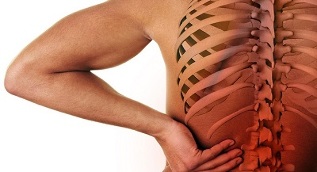
Elderly, professional athletes as well as those whose jobs have to sit still or stand on their feet, are often susceptible to musculoskeletal diseases. Inappropriate daily menu, inactivity leads to erosion and destruction of bone and cartilage. As a result, lumbar spine necrosis develops, symptoms and treatment depend on the individual characteristics of the body, as well as the severity of the damage.
According to the international classification of diseases of the 10th Revision, this disease was assigned the code M42. Sometimes patients are given cumbersome diagnoses, coding that simplifies the doctor's work. This short alphanumeric indication can be recorded on the medical history, outpatient card. So what is lumbar spondylosis? What are the reasons for its appearance? What are the symptoms of the disease? This publication is about everything.
Causes of lumbar necrosis
Lumbar spine tumors often cause trauma and a sluggish lifestyle. Among other things, one of the main roles is played by genetic burden, like the hormonal, chemical, and psychological background of the body.
If a parent has had lumbar necrosis, symptoms and treatment may manifest and pass on to their children. Having inherited the congenital factors, children are born at risk of coping with this disease.
The provocative factors also include the following reasons for the appearance:
- Other diseases, such as gastrointestinal tract, liver, pelvis, nervous system;
- Switches to slow metabolism;
- Shift the acid-base equilibrium towards oxidation (acidosis);
- Reduced motor power;
- Tense situations, anxiety;
- Long awkward poses, incorrect posture.
Usually, sacral necrosis occurs due to hypothermia, hormonal disturbances or pathological congenital defects of the spine.
Symptoms of lumbar necrosis
Signs of lumbar necrosis are related to the fact that spinal nerve fibers pass through the back area inside the spinal canal. Depending on the site, the severity of the failure of some roots, the manifestations of the disease vary.
With necrosis of the lumbar spine, symptoms are as follows:
- Pain syndrome- most patients complain of lower back pain in osteonecrosis. Local pain directly at the site of violation, or it spreads to the buttocks, sacrum of the leg from the injured side;
- Signs of stress- pain increases in a certain position, but when the position of the body changes, the pain disappears suddenly. The most commonly used test is named after the discoverer - Lasegue's syndrome - pain that increases when the limbs are lifted straight, and disappears when the leg flexes in the knee;
- Reduced or increased sensitivity- this symptom is directly related to damage to the afferent nerve, the sensitivity is disturbed not at the pathological site but at some distance. Patients with delirium, paresthesia, or paresthesia, are characterized by abnormal projection sensations, such as goosebumps, tingling, etc. v.
Typically, with lumbar necrosis, motor activity decreases, which is associated with muscle atrophy of varying degrees. In some cases, the functions are limited, in other situations paralysis and paralysis occur.
In addition, lumbar fibrosis is associated with damage to the blood vessels of the spine, with their stimulation and spasm, vegetative changes appear. Blood circulation in the legs slows down, the lower extremities are constantly frozen, the skin is pale. Other organs in the lumbar region are often affected. So, with bladder damage, incontinence develops or, conversely, delay.
Stages of disease

- Grade 1 lumbar fibroids are the primary type of disease. It is characterized by low disc density. Pain syndrome occurs with strong swivel, after exertion or sitting for long periods of time.
This type of disease is common in drivers, office workers, athletes, and people working in extreme climatic conditions. Pain is not characterized by acute attacks but develops into dull or debilitating pain.
At this stage, people should not be in a hurry to see a doctor, but use traditional remedies such as topical medicine and compresses. The situation leads to the fact that the bone necrosis of the lumbar spine or sacrum turns into the second stage;
- Grade 2 lumbar degenerative disease - degenerative and dystrophic disorders of the vertebral joint occur. The spinal cord is compressed, as the nucleus develops and a bulging disc (bulge) occurs.
Neurologists define the second stage of osteonecrosis as low back pain. In other words, low back pain occurs in the lower back when a heavy object is lifted suddenly or with other loads. This stage lasts many years, periods of remission alternate with exacerbations of exacerbations;
- Grade 3 spinal tumors - tuber convex gradually increases, forming a herniated disc. The patient develops a whole palette of neurological conditions: constant pain, irradiation to the buttocks, abdomen, coccyx, legs, urethra, limited movement.
Annotation is used to define a herniation location. The definitive diagnosis of bone necrosis disease L5 S1 means that the bulging of the myeloid occurs between the 5th lumbar vertebra and the 1st cross vertebrae;
- When the right treatment is not done in time, all stages of development go on smoothly to the next. Stage 4 lumbar necrosis disease is characterized by the development of complications.
As a rule, drug treatment for highly developed pathology is characterized by low efficiency. Neurosurgeons are forced to come up with a radical method of herniation surgery.
Methods for diagnosing bone necrosis
To determine bone necrosis of BPTNMT, the neurosurgeon will first conduct a history probe, because the patient's complaint is one of the decisive values for the correct diagnosis. During the conversation, the patient was asked questions about his or her health and condition - what and where pain, how much time it was, what increased sensation of stiffness, whether to proceed. treatment or not, what it is and so on.
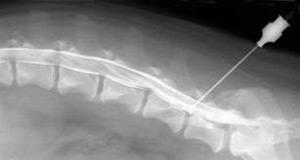
Tool diagnostic method must necessarily be used:
- General Rg graphic image of the lumbar spine- the spine taken in its entirety or in individual fragments taken. More often than others, an Rg-gram targeting is performed on the basis of complaints, in which the doctor notices disc atrophy, a decrease in disc space, the appearance of bone cells, smooth lumbar curvature;
- Spinal Imaging- contrasting liquid is injected into the tube where the spinal cord passes through the spinal canal. This technique is used to define the internal structure of the channel. The average person considers this procedure difficult and dangerous to diagnose, but aside from an allergy to contrast, spinal catheterization is practically no threat to the patient. Perforation is performed in the place where there is no spinal cord;
- Computed tomography- determination of pinched nerve roots, convex tuberculosis, easy to see vertebrae, ligaments, vessels, soft tissue at close range on the screen;
U of the spine is most accurately identified using electromagnetic waves, and the patient is assigned to be examined on a magnetic resonance imaging scanner.
Each tissue has its own incoming signal, the computer processes the data and displays the image on the screen. The doctor examines the vessels, disc, bone process, nerve fibers at a 1 mm cut. At the same time, the patient does not receive harmful ionizing effects.
Treatment of lumbar spinal necrosis
Many patients are interested in the question: what should i do with lumbar bone tumor? Lumbar spinal cord tumors are not always indicated for surgery. The main thing is that after thoroughly examining the patient, the usual treatments are sufficient.
Conservative treatment is reduced:
- For drug treatment;
- Physiotherapeutic procedures;
- Exercises from exercise therapy.
In addition to treating lumbar spine tumors, manual treatments and methods from traditional medicine are used.
For lumbar spinal fibroids treatment regimens are only available to patients in extremely severe cases, if the conservative method does not give the desired results. .
Medicines
Treatment of lumbar spinal necrosis is performed by a neurologist or a spine stenosis specialist. Before treating lumbar fibrosis of the spiral processes, the doctor determines the stage and severity of the pathological disorder.
A muscle relaxant is used to relieve pain, spasm, and inflammation. These drugs quickly return the mobility to the patient, reduce spasms so the pain is gone.
In addition to the muscle relaxants, steroid hormones are sometimes used to eliminate swelling and inflammation.
Gymnastics
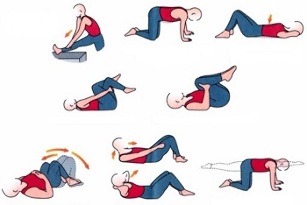
Treatment of lumbar necrosis should be carried out in conjunction with exercise methods. Exercise and sport should be as careful as using drugs.
The therapeutic effects of osteoporosis are exercises that relieve pain, strengthen the muscle frame, and reduce compression between the discs - this slows the progression of the disease further.
Physiotherapy
In systemic osteonecrosis, treatment includes the use of the following procedures:
- Electrophoresis with drugs;
- Laser and magnetic therapy;
- Treatment with a magnetic current;
- Evening;
- UV radiation;
- Treatment with Diadine;
- Shock wave method.
Manipulation involves the use of means utilizing natural physical force: electric current, light radiation, vibration, etc. v. The treatment regimen, the duration of the physical therapy course is determined by the attending physician.
Manual therapy
When a patient asks a neurologist how to manually cure lumbar spondylolisthesis, they are often advised by a specialist, not only the muscle tissue but also thevertebrae in right position.
In the case of lumbar fibrosis, this method normalizes blood and lymph circulation, eliminates muscle deformation and tonicity, and restores motor function. The manipulator's hands reduce the purity of spasm, reduce back pain.
How was lumbar fibroids treated with manual techniques and completely recovered in this way? Manual therapy is indicated only when degenerative processes have not disturbed the tissues of the spine, that is, bone growth has not been formed. The need for these procedures is determined by the doctor after diagnosing Rg, CT or MRI.
Surgery
Surgical treatment of lumbar fibroids is carried out according to certain indications, when the pathology is characterized by the following changes in the spine:
- The spinal shrinks, the disc is compressed and destroyed;
- Cauda equina syndrome develops - a large bundle of nerves of the spinal cone, inside the pelvic region, legs, are damaged;
- Progressive loss of sensitivity, dysfunction of internal organs;
- There is a risk of paralysis in the foot.
Actions to be performed as urgent or scheduled. The goal of surgical treatment is to reduce pressure and improve the condition of the spine.
Traditional medicine
Traditional treatment of lumbar spondylolisthesis is best done under the consultation of a doctor.
People's Pharmacy offers many remedies:
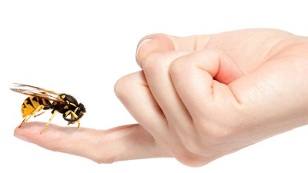
- Medicines, essential oils, extracts of flowers, plant roots;
- Animal products, such as snake or bee venom, badger, dogs, sheep fat, boiled eggs and more;
- Iodine, turpentine, and alcohol are used to warm and relieve irritation.
Similar to folk remedies for genital warts that only treat in the early stages of the disease, the symptoms only go away, not disappear the pathological changes. Among other things, such treatment often has side effects, so a specialist's consultation is required before using any formulations from traditional medicine.
Dosage of any folk medicine or medicine should be prescribed by a doctor.
Complications
Lumbar fibroids in the terminal stage can lead to unpleasant consequences, including disability.
In the background of dystrophic and degenerative disorders, the spinal canal is formed, the stenosis of the spinal canal develops. As a result of such changes, a type of chronic compression is formed, interfering with normal blood flow, ischemia of the roots or the development of cauda equina syndrome.
In addition, diseases such as degenerative spondylolisthesis and spondylolisthesis sometimes develop - the discs age, lose strength, and tend to develop pain due to a disturbance of the structure of the vertebral joint. Complications usually involve the lower spine, the spiny-like bones are formed there.
In the third stage, due to complications of bone necrosis, disc herniation develops, diseases of the genitourinary system and other internal organs emerge.
Precautions
Prevention of bone necrosis of the spine is of no small importance. The lower back has the greatest load, so you need to be especially careful about your back. Remember that regular exercise is the key to a healthy spine.
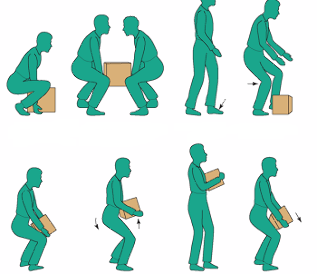
You should lift the weight very carefully to avoid sudden jerkiness. Men and women can carry things out of reason.
Sitting in the office, you need to monitor your posture, follow the correct posture, sit on a straight chair. It is better to wake up every hour and move around in the room, squatting, swiveling: this relieves the tension of the entire musculoskeletal system.
Massage the trigger points is great. They are active or in a latent form. Trigger points occur due to excessive exercise, strong muscle tension, repetitive work, stooping, hypothermia, and other factors.
Knowing the reasons for the development of spasmodic regions, it is necessary to take measures to eliminate their formation. Lately, a trigger point masseuse has gained in popularity; it is better to prevent the occurrence of the sores with a special device than to treat them over a long and costly period of time.

























